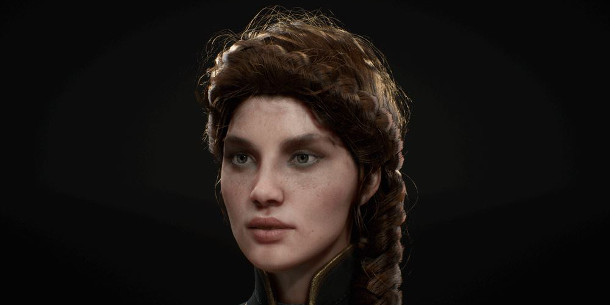Epic Games releases Unreal Engine 4.11
Epic Games has released Unreal Engine 4.11, a big update to its game engine and development environment, boosting performance and adding features ranging from PBR shading for hair and cloth to new animation tools.
The update also coincides with the early releases of two major toolsets for Unreal Engine: the new VR toolset and Sequencer, a non-linear editing system for creating cinematics or even broadcast-quality animations.
Improved threading on multi-core systems
Top of the release notes for 4.11 is performance, in the shape of optimisations Epic has made to the engine for Paragon, its own upcoming MOBA, particularly improvements to threading on multi-core systems.
Epic doesn’t put figures on the resulting speed boost, but animation and cloth simulation are specifically namechecked as benefiting from the work.
New PBR shading models for hair, eyes and cloth
In terms of graphics, the most eye-catching new features – in some cases, quite literally so – are the new physically based shading models for hair (shown in the image at the top of the story), eyes and cloth.
The first two support accurate light scattering and, in the case of eyes, caustics on the iris; the latter, unusually, mimics a ‘fuzz layer’ on the surface of the cloth, giving a realistically soft-looking effect.
In addition, the existing Subsurface Scattering Profile for skin has been updated to improve speed and quality.
New shadow and depth of field options
Other rendering updates include support for ‘capsule shadows’: soft indirect shadows cast by a capsule representation of a character – a render-efficient cheat for visually anchoring a character to the ground.
Another rendering cheat is support for dithered opacity masks, enabling opaque materials to approximate the look of transparent surfaces. The result is noisy, but much faster to calculate.
Where visual quality rather than speed is the priority, sample count for Circle Depth of Field can now be increased further; and a new material function enables DoF to be applied to particles.
The 4.11 release also adds support for instanced stereo rendering – drawing an object simultaneously for both the left and right eye in a VR project, rather than rendering one eye at a time.
The resulting performance boost can be quite significant: according to Epic, it results in an a 14% improvement in CPU time and a 7% improvement on the GPU in its Bullet Train VR demo.
Updates to Lightmass lightmapping
In the lighting toolset, the Lightmass lightmapping system gets support for Intel’s Embree raytracing library, reducing processing time – Epic cites a speed boost of 2.4x on its Sun Temple tech demo.
Lightmass also now supports ‘portals’: a new system for indicating manually which parts of a scene will have the most impact on the calculation, improving quality without significantly increasing calculation time.
Better level of detail handling
The Hierarchical Level of Detail (HLOD) system introduced in Unreal Engine 4.8 also gets an update, including its own Outliner, and support for a wider range of material-generation and texturing methods.
In addition, there is a new option to crossfade between levels of detail using an animated dither pattern, avoiding pop-in on transitions – although the result still isn’t exactly naturalistic.
Users can also remove bones from a skeletal mesh LOD manually, improving animation performance by reducing the quality of the skinning on distant characters.
Simplified secondary animation for characters
In animation, the biggest addition is Anim Dynamics: a new self-contained node for Animation Blueprints that adds dynamic motion procedurally to skeletal meshes without having to use a full physics solution.
By the look of the demo image above, it generates quite realistic secondary motion of props, armour and hair; and there are a range of settings for trading simulation quality against calculation time.
There are also a number of other changes, including the option to synchronise animations using markers in the animation data, rather than simply on scaling them automatically so that their overall lengths match.
There is also an interesting new option to record animations from live gameplay and save them as Anim Sequence assets for use in-engine, or for export in FBX format to third-party tools.
Find a full list of other changes on Epic’s website
Under the hood, support for DirectX 12 has been improved, while Metal is now the default graphics API on OS X El Capitan; and there are a lot of nice smaller features, including improved flipbook rendering for particles.
You can read about them in the release notes, along with non-graphics-related features like the new stereo spatialisation and sound occlusion options.
Coming soon: the VR Editor
The 4.11 release also coincides with updates to two major new toolsets, the first being the VR Editor, shown in action in the video above, which was recorded during Epic Games’ presentation at GDC 2016.
The toolset enables users to use the Unreal editor itself in VR – to “build for VR in VR”. In the demo above, a user navigates scenes and places objects using an Oculus Rift headset and Oculus Touch controllers.
Interface elements appear to float in space within the VR environment, and can be turned on or repositioned at will. In its blog post, Epic describes the UI as “iPad meets Minority Report” – which is actually pretty accurate.
The source code for the VR Editor is available now in Epic’s GitHub repo, with compiled binaries due in June.
Available now: new ‘nonlinear cinematics tool’ Sequencer
Another interesting new work-in-progress toolset is the Sequencer, Epic’s new tool for creating cinematics.
As well as manipulating in-game data, it can record and edit live gameplay, and works in a way that should be familiar to users of standard nonlinear editing software.
It uses a shot-based workflow, with the option to turn effects on and off on a per-shot basis, or to add new effects that don’t exist in the in-game world.
In addition to cinematics, Epic is targeting the toolset at users working outside the games industry: for example, for use in episodic TV animation. You can get a feel for its capabilities from the video above.
Unlike the VR Editor, Sequencer is available in the current binaries, although it’s disabled by default: on its blog, Epic notes that it is “still under heavy development” and is not recommended for use in production yet.
Pricing and availability
Unreal Engine 4.11 is available for 64-bit Windows 7+ and Mac OS X 10.9.2+. Use of the editor is free, but Epic takes 5% of gross revenues beyond the first $3,000 per quarter for any product you release commercially.
Read a full list of new features in Unreal Engine 4.11 on Epic Games’ blog



